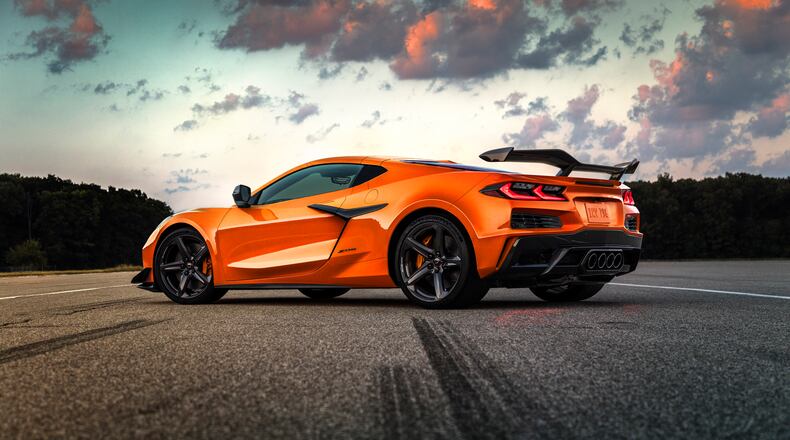The radically reworked Z06 features a host of other changes — many, like the V-8, born in development of the Corvette C8.R race car, which won a championship in its first year of competition and is leading in its second.
“Racing is the reason the Z06 was developed in 1963,” Corvette executive engineer Tadge Juechter said. “We’ve tested the Z06 on the best tracks in the world, from Circuit of the Americas here in the United States, to the Nürburgring in Germany.”
The interior also got a host of upgrades, including performance-oriented displays, carbon fiber trim with subtle red highlights and a raucous “dipped-red” color package.
The 2023 Chevrolet Corvette Z06 goes into production next summer in Bowling Green, Kentucky. It’ll be available both as a coupe and convertible. Prices and fuel economy will be announced closer to when sales begin.
Corvette Z06 through the years
C2 (1963): 5.4L V-8 engine, 360 horsepower, 4-speed manual transmission
C5 (2001-04): 5.7L V-8, 385 hp (2001) and 405 hp (2002-04), 6-speed manual
C6: 7.0L V-8, 505 hp, 6-speed manual
C7: 6.2L V-8, 650 hp, 7-speed manual or supercharged 8-speed automatic
C8: 5.5L V-8, 670 hp, 8-speed dual-clutch automatic
When tenths of a second get hard to find
“Visceral,” “urgent” and “scalpel” were the keywords when the ‘Vette team started working on the Z06 in 2019.
The bodywork was widened to accommodate a 3.6-inch wider stance necessitated by massive 345-series rear tires and bigger side air vents for cooling.
Four 5-foot-long “strakes” on the underbody direct air out from under the car to reduce air pressure and increase roadholding.
“The steering response is in another universe” due to the big tires and light wheels, Juechter said. Engineers retuned the ‘Vette’s steering, suspension and eight-speed dual-clutch automatic transmission for more power and higher speeds, but the basic components, including MR adaptive suspension, are common with the Corvette Stingray.
Race-bred features available on the Z06 include:
—A stance 3.6 inches wider than the Corvette Stingray
—A whopping 734 pounds of aerodynamic downforce to keep the car planted securely on the track instead of risking liftoff at top speed — 186 mph
—Standard 20-inch front and 21-inch rear aluminum wheels
—Optional carbon fiber wheels that cut weight 41 pounds
—Optional Brembo carbon ceramic brakes with 15.7/15.4 inch diameter front and rear rotors, respectively
The Z06′s grille, front fenders and fascia are new to accommodate more air flow for cooling and aerodynamics. The rear fascia and corners are also new, including repositioned taillights. The hood and headlights are shared with the Stingray.
The engine, however, is new from the ground up. In development for more than five years, it has 32 valves and dual overhead cam shafts, more small-block firsts. The high-pressure direction injection system is the exact same one used in Corvette C8.R race cars at tracks from Daytona to LeMans. Engineers also borrowed some tricks from Chevy’s Indy Car engine, including moving the fuel rails to the exhaust side to make room for bigger intake valves.
The resulting improved air flow helped the absurdly powerful engine meet emissions standards.
Top speed is 186 mph. The 0-60 mph time fell to 2.6 seconds, about 0.2-0.3 of a second faster than the Stingray.
That was unexpected, Juechter said. “Tenths of a second get pretty hard to find when you’re down to that few of ‘em.”
The focus of all the improvements was to allow the Z06 to run its fastest lap times all day long, with less falloff from heat and other factors than previous models.
The Z06: Zora’s secret project
The Corvette Z06 dates to the sports car’s early days, when legendary chief engineer Zora Arkus-Duntov wanted a ‘Vette he could race and win with on the track. The name dates to the special package of features created to do that in 1963: Zora Option 6 or Zora 06. The Z06 (pronounced “Zee Oh Six,” but written with a zero, not an O) was born.
The model name wasn’t even in the order book. It was a secret package of features cobbled together by Zora, an avid and accomplished racer.
Buyers in the know could request it to get a track-ready ‘Vette. Chevy didn’t officially acknowledge the Z06′s existence, perhaps because GM briefly abandoned motorsports in 1963.
The original 1963 Z06 package included:
—Stiffer suspension
—Heavy duty brakes
—Thicker front stabilizer bar
—A 36-gallon fuel tank to reduce the number of pit stops in longer races
—A fuel-injected 5.4-liter engine (327 cubic inches) V-8
—Close-ratio four-speed manual transmission were required with the package
The 5.5L V-8 — the first small-block with a flat-plane crankshaft — has the distinctive fast-revving exhaust note that used to be the province of exotic cars like McLaren and Ferrari. Without getting too deep in the weeds, a flat-plane crankshaft reduces engine weight and improves airflow. That leads to more power. The design also leads to more engine vibration than engines with conventional counterweighted crankshafts, and a distinctive exhaust note, very different from traditional Detroit V-8s. It revs to the 8,600 rpm redline quick as a hiccup.
There will be Z06s as long as there are Corvettes — which means as long as there are Chevrolets. Someday, they’ll have electric power, and probably even quicker 0-60 times than the 2023, but they may never exceed the 5.5L flat-plane small-block’s visceral appeal.
2023 Chevrolet Corvette Z06 at a glance
Two-seat midengine coupe or convertible
Price: TBA
On sale: Fall 2022
Rear-wheel drive
On sale December 2021
Engine: 5.5L DOHC flat-plane crank V-8
Output: 670 hp @ 8,400 rpm; 460 pound-feet of torque @ 6,300 rpm
Transmission: Eight-speed dual-clutch automatic
Estimated EPA fuel economy rating: TBA
Wheelbase: 107.2 inches
Length: 184.6 inches standard; 185.9 with carbon fiber ground effects
Width: 79.7 inches
Height: 48.6
Dry weight: 3,434 pounds with carbon fiber wheels and Z07 package
Cargo volume: 12.6 cubic feet
Assembled in Bowling Green, Kentucky
Mark Phelan is the Detroit Free Press auto critic. He can be reached at mmphelan@freepress.com.
About the Author

